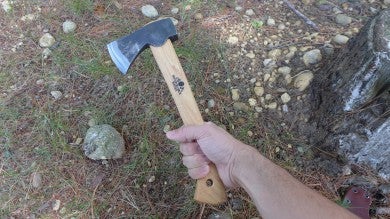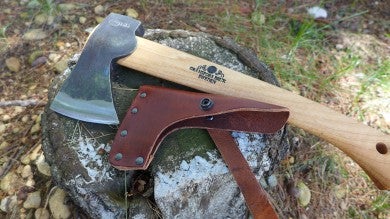A Newb’s Take on Chopper v. Hatchet, Part III
Tony Sculimbrene 11.04.14

So far in our series, we’ve covered four lessons that I’ve learned in exploring the world of big choppers and hatchets. I’ve saved the biggest lesson for the end: handles are the absolute most important part of either a chopper and a hatchet.
Lesson #5: Handles, Handles, Handles
If the first rule of real estate is location, location, location, and the first rule of a hard use cutting tool is handles, handles, handles. In my opinion, this is the most important part of the tool, especially if you are newbie. The amazing Becker handle has changed the way I view fixed blades. Even compared to custom handles on high end puukos, I still prefer the Becker handle.
Just a few steps behind though is the handle on my GB hatchet.
The curve at the end of the handle and the superbly finished wood are very nice, even after long chopping sessions.
The thing that I have learned is this: so many knives, especially folding knives, focus on the index finger position. And there is good reason for this. It provides a lot of control and allows for precision work. But in a chopper or a hatched where big swings are the norm, it’s the end of the handle that matters. Almost by definition you can’t use either of these tools for precision work. There needs to be a good amount of hook, especially in bigger knives, to help keep the blade in your hand. The same is true, to a lesser degree, with hatchets, so pay attention to the end carefully. I’d also like a lanyard hole at the end of the handle for just a bit more insurance, and both the BK-9 and the GB Wildlife Hatchet have both.
The reason why you need this design feature is a matter of physics. With small and medium sized knives (anything under 5 inches or so), the momentum of the knife is probably not enough to carry the blade out of your hand, but when you step up to something like a 7 inch knife, you really need that hook, usually called a parrot’s beak. The distribution of the weight of a hatchet makes the parrot’s beak a requirement.
I have reviewed a number of choppers and many of them have good handles. I especially like the Spyderco Rock‘s handle, but even the masters of ergonomics in Golden can’t compete with the Becker handle. Among choppers (and fixed blades in general), it’s the best I have seen. Similarly, the GB handle is just amazing among the competition (besting the Wetterling handle by a wide margin). But all of this experimentation and use has proven to me that in a chopper or hatchet, worry about the handle first, and if it is good, look at the blade next.
Conclusion
Right now I am firmly in the chopper camp, but owning and using a GB hatchet for awhile has proven to me that this is a tool I need to spend more time with to fully understand its capabilities. The steel on a GB hatchet rivals that of steel on much more expensive fixed blade knives, and the handle is phenomenal.
With more skill and a small fixed blade as a complement, I think the hatchet might be better, but right now I feel much more comfortable with the big knife. It’s not great at anything, but it is good at a lot of things, and in a pinch you can force it to do small knife tasks.
One last thing I would note is that both the Wetterling and the GB axes and hatchets have superb sheathes, much, much better than the sheathes on equivalently priced knives. The “cordura sock” sheath that the BK-9 came with is actually good, compared to the field (the sheath on the Ontario Ranger RD-7 I had was wretched). You have to step up about $50 to get a good sheath on a chopper, and they are usually kydex, which I like, though it lacks the appeal of a good leather sheath like this one:
The Wetterling sheathes are similar, and this leads me to believe that sheathes on axes and hatchets in this price range, regardless of brand, are just better. It’s interesting to note that the attachment method for a hatchet, involving weaving the snap strap around your belt, lets you carry the hatchet very securely and it is much more comfortable than the normal cordura sock sheathes on choppers (and much better than the stiff kydex sheathes out there).
While it is entirely possible that with more skill I will strongly prefer the hatchet, I also think that there are some large fixed blade designs that might keep me in the chopper camp for a long time, if not forever. In particular I really like the parang blade shape. A sufficiently large and sufficiently long parang could be so good that the whole hatchet/axe thing might never seduce me. I also would like to try a true kukri. The Spyderco Rock‘s kukri elements were my favorite parts of that knife, so I can see how a real one might be even better. Then there are the host of new blade shapes in the chopper world. TM Hunt’s M-18 looks very promising, as does the Bark River prototypes for their version of the Tracker knife. A BRKT Tracker, with its normal amazing fit and finish plus some 3V, might be impossible to resist.
I can’t say the high end world of hatchets and axes is as appealing. John Neeman’s stuff, of course, looks good and functional. Additionally, the Wranglestar stuff is nice, but I cannot see either of them being substantially better than my GB hatchet. And no, I am not interested in axes from New York City with painted handles.
It might be that I am just so blinded by trends and what I have used in the past, but if I could only have one or the other, right now I’d take a big chopper. A full sized axe would win if I were doing only tree cutting work, but as an all-around outdoor tool, I feel more comfortable with a big chopper than I do with a hatchet.
Of course, the REAL answer is to do what I did. Get both. Christmas is coming after all.

